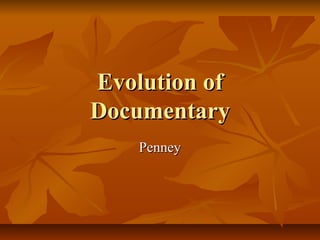
Evolution of Documentary from Entertainment to Social Impact
- 1. Evolution of Documentary Penney
- 2. Objectives Film began with a simple objective, entertainment. Media desired only to show not to inform. During the 20’s, Grierson changed this, desiring to educate and socially impact the masses, thus changing film into something morally constructive to society.
- 3. Influences Battleship Potemkin was a great influence for Grierson’s desire for this change, the Soviet government’s control of, and educational values of film allowing for this greater unified purpose. This was a great inspiration for Grierson, and soon attempted to emulate this change himself.
- 4. First Age of Documentary Pre-Grierson, the entertainment industry focused more heavily on simple aesthetics'. However, after Grierson embraced the ideal of educational film, the trend was easily picked up, and marked the advent of a much more convenient and accessible medium of information sharing. This can be seen as a ‘pure’ age of documentary.
- 5. 2 World War and Documentary nd The birth of the Second World War had a massive impact on documentary, as it was the advent of propaganda being used in such a medium. This tactic was employed heavily by both sides of the conflict, one of the most famous being the Nazi parties, Triumph des Willens which was a large draw of Nazi support.
- 6. Constant evolution Since the war, documentary has continued to be used in such a way as to affect and manipulate the viewers into acting or thinking differently. As technology advanced so did this level of control, with techniques such as subliminal messaging being introduced to quickly and effectively impact audiences, in addition to societies increasing media dependancy.
- 7. Social Impacts Documentary has an advantage over other forms of visual media when it comes to highlighting social issues. This comes from it’s portrayal of anything from poverty, to minority groups whilst appearing un-biased, factual and genuine. This garners empathy from viewers without the documenter/s having to relinquish the advantage of staging all the action shown.
- 8. Distribution The increasing access to shared media via television and internet birthed new opportunities for documentary as they could now be marketed to worldwide audiences at any of time of the day. This allows for more freedom of influence to the minds of the worlds media consumers, feeding our media dependency and promoting documentary as a recognised, legitimate form of research and information gathering.